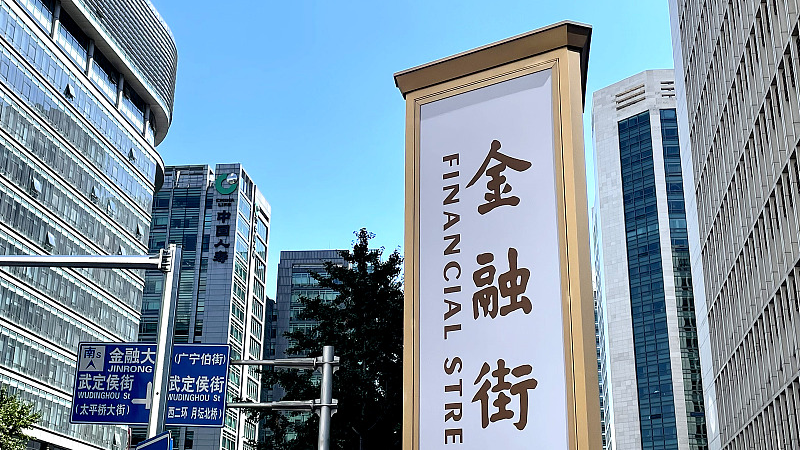
The Financial Street in Xicheng District, Beijing, China, August 17, 2022. /CFP
The Financial Street in Xicheng District, Beijing, China, August 17, 2022. /CFP
Editor's note: Liu Chunsheng is an associate professor at the Beijing-based Central University of Finance and Economics. The article reflects the author's opinion, and not necessarily the views of CGTN.
The annual Financial Street Forum is being held in China's capital city of Beijing from November 21 to 23, focusing on economic development and financial cooperation amid unprecedented changes.
Deeply influenced by challenges such as COVID-19 pandemic and world economic downturn, market entities in China are undergoing a tense situation. The Forum is therefore being convened at a right time and provides a strong impetus to China's market entities.
The People's Bank of China (PBOC) has said, in its third-quarter monetary policy report, that financial support will be provided in particular for weak economic links and sectors hit hard by the pandemic, and loans to small and micro firms and private enterprises will also be encouraged.
Indeed, small and micro firms are facing tough situations such as reduced orders and cooling market demand. At the same time, bottlenecks such as weak risk bearing capacity and large financing risks have plagued the rapid development of small and micro firms, which has also exacerbated their increased demand for credit.
Small and micro enterprises are the significant players in China's market. In order to combat the pandemic and help small and micro firms to overcome difficulties, the PBOC and the China Banking and Insurance Regulatory Commission have issued preferential policies such as targeted reduction of reserve requirements for inclusive finance, provision of rediscount and refinancing, exemption of value-added tax on interest income, and establishment of a national financing guarantee fund to increase credit support for small and micro firms.
China now has over 150 million market entities. They have made great contributions to China's national economy, and contribute more than 50 percent of tax revenue, more than 60 percent of GDP, more than 70 percent of technological innovation, more than 80 percent of employment, and account for more than 90 percent of market players. However, for a long time, they are all "marginalized groups" that are difficult to be covered with financial resources. During the pandemic and cooling economy, financing constraint is threatening the survival of small and micro firms.

A garment factory in Jingxing County, Shijiazhuang City, north China's Hebei Province, February 5, 2021. /Xinhua
A garment factory in Jingxing County, Shijiazhuang City, north China's Hebei Province, February 5, 2021. /Xinhua
It is also unfair to blame financial institutions. Commercial banks have many pain points in serving small and micro firms. First, small and micro enterprises have weak risk resistance capability and high credit risk. According to the Fortune magazine and China's private enterprise development report, the average life cycle of small and medium-sized enterprises is 2.5-2.9 years, and they are suffering financing constraints for lack of collateral. The non-performing loan rate of small and micro firms is generally far higher than the average level.
Besides, due to the nonstandard finance and opaque management of small and micro firms, it is difficult to standardize the credit process, which takes more human resources, higher service costs and longer approval time with lower business efficiency.
In recent years, Chinese governments have continued to increase the supply of incentive policies, and promote inclusive finance in financial institutions. The establishment of inclusive systems and mechanisms has helped to enhance the commercial banks and other financial institutions' initiative of financial inclusion.
The authorities constantly optimized relevant laws and regulations on inclusive finance, and created a good development environment for inclusive finance; financial institutions have incorporated inclusive finance into their corporate strategies.
In fact, from the perspective of market demand, the rapid growth of the total number of small and micro firms provides a broad space for relevant financial services development. The number of small and micro firms registered increased from around 11 million in 2012 to 48 million in 2021, and the number of self-employed businesses exceeded 100 million. In particular, since 2016, the number of new self-employed businesses has accounted for more than 60 percent of the total number of new market entities. Behind the main body of the small and micro market with more than 150 million households, there is a huge blue ocean. Inclusive finance plays a valuable role in it.
The effective empowerment of financial technology has promoted rapid growth of inclusive financing. Long tail customers such as small and micro firms are massive, decentralized and have different demands, which are difficult to reach effectively with conventional techniques.
Big data, cloud computing, artificial intelligence and other technologies are becoming more mature and widely used in the financial field, establishing an active credit model, so that the past "artificial" financial businesses can be plugged into the "digital" wings to improve efficiency, expand scale and optimize customer experience.
In the next stage, China will continue to build a long-term mechanism with affordable costs and sustainability, promote the integrated development of inclusive finance and green finance, supply chain finance, etc., create a good ecological environment for the development of digital inclusive finance to foster the development of more small and micro firms.
(If you want to contribute and have specific expertise, please contact us at opinions@cgtn.com. Follow @thouse_opinions on Twitter to discover the latest commentaries in the CGTN Opinion Section.)